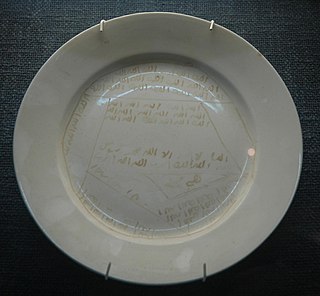| Location | Tripoli, Libya |
|---|---|
| Type | Natural-history museum |
The Natural History Museum of Tripoli is a museum located in Tripoli, Libya. [1] It was developed by Professor Zahid Baig Mirza (Z. B. Mirza). [2]

Libya, officially the State of Libya, is a country in the Maghreb region in North Africa. It is bordered by the Mediterranean Sea to the north, Egypt to the east, Sudan to the southeast, Chad to the south, Niger to the southwest, Algeria to the west, and Tunisia to the northwest. Libya is made of three historical regions: Tripolitania, Fezzan, and Cyrenaica. With an area of almost 1.8 million km2 (700,000 sq mi), it is the fourth-largest country in Africa and the Arab world, and the 16th-largest in the world. Libya has the 10th-largest proven oil reserves in the world. The largest city and capital, Tripoli, is located in western Libya and contains over three million of Libya's seven million people.

Tripoli is the capital and largest city of Libya, with a population of about 1.1 million people in 2019. It is located in the northwest of Libya on the edge of the desert, on a point of rocky land projecting into the Mediterranean Sea and forming a bay. It includes the port of Tripoli and the country's largest commercial and manufacturing center. It is also the site of the University of Tripoli. The vast Bab al-Azizia barracks, which includes the former family estate of Muammar Gaddafi, is also located in the city. Colonel Gaddafi largely ruled the country from his residence in this barracks.
The thin sand rat or lesser sand rat is a species of rodent in the family Muridae. It has also been previously named the pale sand rat based on work published by Oldfield Thomas in 1925. It is found in Algeria, Libya, and Tunisia, and its natural habitats are subtropical or tropical dry shrubland and intermittent salt lakes. The thin sand rat was previously classified as a subspecies of the fat sand rat. However, morphological differences in size and coat color between the two animals, along with recent molecular evidence suggest that they are different species. The thin sand rat may be a natural reservoir for the disease leishmaniasis.

Italian settlers in Libya typically refers to Italians and their descendants, who resided or were born in Libya during the Italian colonial period.
This page list topics related to Libya.

The Red Castle Museum, also known as As-saraya Al-hamra Museum, the Archaeological Museum of Tripoli or Jamahiriya Museum, is a national museum in Libya. It is located in the historic building known as the Red Castle of Tripoli, sometimes also referred to as Red Saraya, on the promontory above and adjacent to the old-town district with medina Ghadema.
The Libyan Civil Aviation Authority is the civil aviation authority of Libya. Its head office is at Tripoli International Airport in Tripoli.
The Tripoli Central Hospital is a general hospital, located in Tripoli, Libya.

The Martyrs' Square ; known as Green Yard under the Gaddafi government; Independence Square during the monarchy; and originally known as Piazza Italia is a downtown landmark at the bay in the city of Tripoli, Libya. The main commercial center of the city surrounds the square. The Square is also a main tourist attraction in Tripoli. It has a large legendary fountain done by an Italian architect at the centre of the square. The square is the meeting point of many different avenues. Omar Mukhtar Avenue is one of the longest in North Africa, it was built by Italians in the colonial time, and Libyans during the era of King Idris I. Independence Street branches from the square too, and it leads to the Palace of King Idris I. 24 December Avenue is also an Italian built avenue. Mizran Street is the last street that branches from the Martyrs' Square.

The Islamic Museum of Tripoli is a proposed museum of Islamic culture that was built under the support and patronage of Saif al-Islam Gaddafi in Tripoli, Libya.
The Epigraphy Museum of Tripoli is a museum located in Tripoli, Libya.
The Ethnographic Museum of Tripoli is a museum located in Tripoli, Libya.
The Prehistory Museum of Tripoli is a museum located in Tripoli, Libya.

The Museum of Libya is a museum located in Tripoli, Libya. It was originally built as the Royal Palace, completed in 1939. It was later used by King Idris during his reign. It then became known as the "People's Palace" after the fall of Ghaddafi.
The Janzur Museum is an archaeological museum located in Janzur, Libya. The museum showcases a funerary complex that is still under excavation by the Archaeology Department in Tripoli.

The Karamanly House Museum is a historic house and museum located in the Old city in Tripoli, Libya. It is associated with the Karamanli dynasty.
The Libya Herald is an English-language newspaper based in Tripoli, Libya, launched on 17 February 2012.

The Embassy of the State of Palestine in Libya is the diplomatic mission of the Palestine in Libya. It is located in Ben Achour area in Tripoli.

The Red Castle, in Arabic As-saraya Al-hamra, sometimes also Red Fort or Red Saraya, is a major landmark on the waterfront of Tripoli, bordering Martyrs' Square. It has been the home of the Red Castle Museum since 1919, and of the Libyan Department of Archaeology since 1952.
{{cite web}}: CS1 maint: url-status (link)